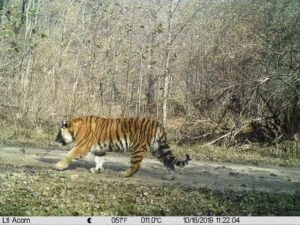Living amongst apex predators brings with it certain risks and with conservation actions focused on increasing the population of wild tigers, opportunities for conflict are increasing. Mitigating these risks and helping people find ways of living safely in coexistence with tigers is an important part of conservation. You cannot remove the human piece of the puzzle but need to fit all the pieces together.
WCS China has been working in Hunchun Nature Reserve since 2006 collaborating with the government of China and the local Hunchun Municipal Forestry Bureau to monitor Amur leopards and tigers and to establish efficient and professional human-wildlife conflict responses.
Since July 2019, it is reported that there have been four cases of human-tiger conflicts (encounter) in Hunchun.
In response to the frequent human-tiger conflicts, in order to protect people’s safety, the WCS China tiger team published an article on the public account of WCS WeChat on September 28, 2020. Aimed at those living amongst apex predators gave the general public some strategies of what to do if they came into contact with wild tigers and leopards.
The article included the story of two recent human-tiger encounters in Hunchun and some scenarios and strategies to deal with similar occurrences.
WildCats Conservation Alliance has translated (thanks to Google) and paraphrased the article, presented from the view of a tiger, here:
On July 17, 2020, in Hunchun, Jilin province, a taxi driver encountered an Amur tiger “blocking the road” while passing by a highway near Hadamen township Sandaogou village. The driver stopped and waited for 20 minutes before the tiger left.
On September 19, 2020, two employees of Hunchun Zijin Mining met a tiger jogging on the road and appeared in the bushes beside the road.
What to do when encountering a tiger?
Encountering our baby tiger: When our human friend meets a baby in the wild that is not under the care of the tigress, never try to catch it, because the mother tiger may be lurking nearby. In addition, do not underestimate cubs, their attack is powerful and can be fatal to humans.
Don’t take the family dog into the mountains to meet us: We tigers will hunt and kill dogs and have been known to follow people travelling with dogs for hours without being noticed. We will attack when the dog strays away from the owner. If the first attack fails, the dog will return to the owner to seek safety threatening the safety of our human friends.
If you encounter us with our kill: Do not approach the prey, or try to take. It is our nature that we will be watching nearby or will follow the traces of the prey.
If you encounter an injured or old tiger: When we are injured or old, we may lose the ability to catch our food, but it does not mean that we lose the ability to attack completely. Hunger can force us to go to residential areas, garbage dumps, to eat the carrion of animals, or to attack domestic animals and dogs.
If you encounter a tiger that has been trapped: When we are trapped by a snare, we will be very aggressive, and we will try to kill any human close to us. We might howl and struggle until you no longer approach. If you continue to approach, we might stay still and wait for opportunities to attack at close range. If we break free of the trap human friend, there will be no hope of survival.
If you encounter us on the road: We will sometimes pass by a highway or become curious. We will not always avoid vehicles but aren’t as interested in cars as motorcyclists. Cyclists are the most vulnerable because humans on bicycles can be seen as fast-moving “animals”, which stimulates our chase behaviour.
How to prevent an encounter with tigers
- First of all, when we find someone in our territory, we will hide in the dark and observe our human friends. If we take the initiative to show up infront of people (or yell at them) but do not directly attack, it means that we do not regard people as prey. We are warning human friends that there are cubs or prey nearby. Of course, sometimes we will treat people as unwelcome competitors and warn human friends that we are the masters here. At this time, what you have to do is: leave this dangerous area as soon as possible, don’t panic, don’t turn your back to our tiger, let alone run away from the scene quickly.
- When human friends did not understand the demonstration correctly, and moved on, leading to too close to us, or cubs or prey. We will be forced to take further self-defence actions and even launch attacks. In fact, when human friends suddenly appear in front of us, we often suddenly freeze and become nervous, so we yell at demonstrations and pretend to attack. At this point, you can: as much as possible make noise to scare us away. Human friends can try shouting, banging metal, shaking trees to make noise, or use flames, flares or firecrackers. Remember, be careful not to cause forest fires.
- If we really intend to attack human friends, we usually knock people down first. If we did not kill human friends in the first place (maybe just out of curiosity to learn about human beings), then humans still have a chance to survive. In this case, you’d better to lie down and don’t make any fierce resistance. If the enemy does not move, I will not move, because defenceless resistance is useless, but it will irritate us and cause unnecessary harm.
- If we throw our human friends down and continue to attack, we will start from the neck at this time, so what you have to do at this time is to protect your neck first to avoid being bitten by us. At the same time use any weapons within reach to counterattack, such as fire flare, wooden sticks, stones, etc.
- It is absolutely forbidden to hunt any wild animals such as roe deer and wild boar because they are our prey, and the reduction of prey will increase the probability that we will prey on domestic animals. If hunting traps and hunting traps cause us to be injured, and we are angry and hungry, we will threaten the safety of people and livestock more seriously.
- It is necessary to maintain the sanitary conditions in residential areas and nearby houses. It is forbidden to pile up rubbish that will attract big beasts like us, especially animal carcasses and fur.
- In our tiger habitat, it is best not to keep dogs. As mentioned earlier, dogs are prone to attack from tigers. Not only are they hard to protect themselves, but they can also harm human friends.
- Relevant departments should put up warning signs in areas where we and leopard brothers live “tigers and leopards live here, pay attention to safety” to avoid harm to nearby people.
- Before entering our tiger habitat, you should fully understand our activities on this site. If we have attacked domestic animals and dogs, or someone has seen us, it is recommended not to enter this forest.
If you must enter, you must pay attention to several points:
- Do not enter the mountain forest after evening.
- Do not act alone, at least three people travel together.
- Patrol and investigators should be equipped with tiger-driving tools. It is recommended to use flame signal flare and hold it in your hand at any time for emergencies. Residents in the community can carry tools that can make loud noises, such as metal barrels, gongs, and firecrackers.
- Horse riding is not recommended. If you must ride, it is forbidden to let it go. The resting horses often attract tigers and bears.
- Avoid crouching in the forest. Many tiger killings occur when people crouch. Tigers are naturally afraid of human shapes, but a crouching person looks more like a tiger’s prey.
- If you find fresh tiger footprints, you should be extra vigilant and take precautions. Leave the area as soon as possible, and make a human-specific noise (such as loud roaring, knocking on metal, etc.) to warn the tiger.
- If you find tiger prey, do not approach it, let alone take it away even if there is no fresh tiger footprint nearby.
This article is based on a guide Community Guide for Tiger Conservation and Human tiger Conflict Response Strategy published by WCS for use in the local community using a grant from WildCats Conservation Alliance.





